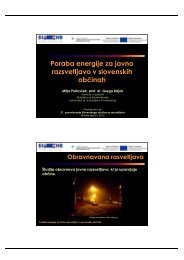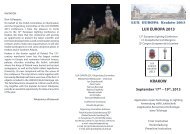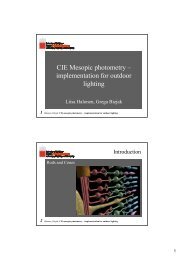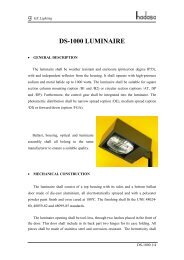Zbornik - SDR
Zbornik - SDR
Zbornik - SDR
Create successful ePaper yourself
Turn your PDF publications into a flip-book with our unique Google optimized e-Paper software.
“Lighting Control Systems To Improve energy performance…” R-5<br />
2 Lighting control and the quality of lighting design<br />
A new phase of the cultural debate on the significance of a lighting project began in the nineties:<br />
the definition of the concept of lighting quality took on a value that went beyond purely illuminating<br />
engineering aspects [1] [2] [3] [4].<br />
Agreement has traditionally been reached on recognising that light has an influence on:<br />
- vision;<br />
- visual performance in carrying out a task;<br />
- subjective behaviour;<br />
- determination of a state of mind;<br />
- health;<br />
- formulation of an aesthetical evaluation.<br />
An illuminated environment, characterised by a good quality, should therefore:<br />
- create optimal perception conditions;<br />
- create optimal conditions for carrying out an activity or precise visual task;<br />
- favour correct behaviour;<br />
- contribute to the determination of appropriate states of mind;<br />
- favour healthy conditions and avoid phenomena that are dangerous for one’s health;<br />
- contribute to the creation of an appreciable aesthetic environment, taking into<br />
consideration and valorising the architectonic characteristics.<br />
Considerations from the 1998 CIE Symposium on Lighting Quality [1] have made the concept of<br />
lighting quality a more holistic approach, apart from falling back on the sphere of visual comfort and<br />
related criteria (illuminance, light<br />
distribution, glare, etc.), greater<br />
importance has been given to the<br />
HUMAN NEEDS<br />
role of aspects, not directly dealing<br />
Visibility<br />
with lighting, underlying the<br />
Task performance<br />
multidimensional nature of the<br />
Visual comfort<br />
lighting design. In the proposed<br />
Social communication<br />
model (Fig. 1) the definition of<br />
Mood and atmosphere<br />
lighting quality encompasses the<br />
Helth, safety, well being<br />
spheres of human needs,<br />
Aesthetic judgment<br />
architectural integration, and<br />
environmental/ economic con-<br />
LIGHTING<br />
straints.<br />
ECONOMICS AND<br />
QUALITY<br />
ARCHITECTURE<br />
Form<br />
ENVIRONMENT<br />
Installation<br />
Maintenance<br />
Operation<br />
Energy<br />
Environment<br />
Composition<br />
Style<br />
Codes and<br />
standards<br />
Fig. 1 – Lighting Quality definition developed at First CIE<br />
Symposium on Lighting Quality [4]<br />
Within this framework it is<br />
clear that the use of lighting<br />
controls might have a positive<br />
influence on the global quality of<br />
lighting design. These systems are<br />
intended to increase the flexibility<br />
of lighting and optimise energy<br />
consumption, taking into account<br />
actual space occupancy and<br />
daylight availability during<br />
“Lighting engineering 2006” stran 39
















